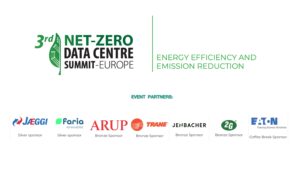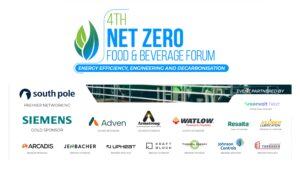The European digital infrastructure landscape is undergoing a transformation or a deep structural reorientation. We are witnessing the historical grip of the Data Center Europe centers, or FLAP-D (Frankfurt, London, Amsterdam, Paris, Dublin), disintegrating. This occurs due to a severe energy crisis, emerging & stringent regulations, & the huge power requirements of generative AI applications. This transition indicates a significant re-architecture, with industry investments actively pouring into Tier II and greenfield locations. This is a trend that is forecasting a tremendous decline in FLAP-D Market Share by 2035.
This article will fully analyze the impetus behind this decentralisation. It will take a look at it all, right from the grid constraints & new EU compliance requirements to the technical revolution of liquid cooling & demand for data sovereignty in a contemporary Data Center Europe.
The Grid Bottleneck and the AI Power Tax
Contemporary hyperscale & AI data centers are consuming a record level of power. It is placing inordinate stress on mature, usually aging, grid infrastructure. This stress prompts utility suppliers to declare Data Center Moratorium periods. It also generates very long timescales for connecting new grids to historically popular metro areas. So, this renders them unsuitable for rapid deployment. This section explores how limitations on power compel emerging models of operations. Also, you will discover how sluggish connection latencies drive investment off traditional hubs towards more green, quicker-to-deploy markets:
The Pivot to Grid-Interactive Data Centers (GIDC)
The severe overload on power grids actually compels Data Center Europe facilities to fundamentally shift their business model. They simply cannot be passive power consumers anymore. Instead, new data centers will need to be active partners with the grid. This is through the ubiquitous installation of Battery Energy Storage Systems (BESS) and advanced demand-response capabilities. Operators tap their BESS capacity ( in many cases, massive lithium-ion or flow batteries) to flatten power draws. In other words, they charge up these systems during off-peak times or when renewable energy output is high.
Then, they release the stored energy at high-congestion periods or when the grid is under serious constraint, as per Transmission System Operator cues. This demand-response facility, commonly required for new locations in constrained grids, calls for real-time control systems. These can ramp up generators or shift to battery supply within milliseconds. This systematic change fundamentally moves the data center’s value proposition from merely hosting compute to actively supporting grid stability. Thus, it alleviates Data Center Grid Constraints Europe in surrounding regions.
The 7-Year Connection Wait Time and the Loss of Time-to-Market Advantage
Operational challenges in legacy markets create prohibitive friction for new developments. This is because securing the necessary multi-gigawatts of power easily involves lead times stretching between seven and ten years. This wait time fundamentally dismantles the time-to-market advantage. This once made established locations like London or Dublin attractive. Hyperscalers and wholesale colocation providers, especially those focused on rapid generative AI deployment, find waiting nearly a decade for power an unacceptable business risk. So, this effectively kills the project’s economic viability.
Consequently, this lengthy timeline makes the older hubs non-viable for rapid expansion. It prompts a calculated shift of major investment and development focus to Tier II markets. These new markets often have deliberately overbuilt transmission infrastructure, securing substantial power connections in two years or less. This disparity in connection speed highlights a critical infrastructure failure in the traditional hubs. It accelerates the decrease in FLAP-D Market Share. It also pushes new developments toward markets without the threat of a looming Data Center Moratorium.
Decentralisation to High-Renewable Tier II Markets (Nordics & Iberia)
The market is aggressively pivoting toward Tier II locations, specifically the Nordics (Sweden, Denmark, Norway) and Southern Europe (Spain, Portugal). They offer a far more compelling value proposition for a new Data Center Europe. These markets have available, uncongested grid capacity and immediate access to low-cost/ high-volume renewable energy locked up. This is through long-term Power Purchase Agreements (PPAs). Operators avoid the expense and complexity of retrofitting brownfield sites in incumbent hubs by constructing greenfield hyperscale campuses in these new markets. This obtains 100% renewable power from day one.
The attractiveness of these regions is multifaceted. It is less about latency and far more about the total cost of ownership and carbon footprint. The combination of cheaper land, inherent free cooling (especially in the Nordics, reducing PUE), and the total lack of Data Center Grid Constraints Europe results in a facility that is:
- Technically superior,
- Faster to deploy,
- And inherently more sustainable.
Developers lock in PPAs that guarantee renewable sourcing and price stability for decades. It is a financial and environmental advantage that legacy Data Center Europe markets cannot compete with. Thus, it reinforces EU Data Center Trends toward decentralisation.
The New Regulatory Wall: EU Compliance as a Site Selector
Europe’s evolving legislative environment is changing the game for data centers. It is actively transforming energy performance from a simple competitive edge into a non-negotiable compliance mandate. This strong regulatory framework penalises older, less efficient facilities. They are often heavily concentrated in the established FLAP-D hubs, driving the demand for a more sustainable Data Center Europe. So, this section discusses how the main EU regulations are directly affecting the movement of capital and the very process of site selection for new developments:
The EU Taxonomy: The Mandate for Green Financing and Capital Flight
EU Taxonomy is a historic legislation that specifically determines what is a “sustainable” economic activity within the EU. It is revolutionary in its effect on investment decisions for Data Center Europe. This measure pushes investors, financiers, & developers to report publicly how their data center facilities follow the strict sustainability requirements. This mainly includes climate change mitigation. If a data center, particularly an older facility in the FLAP-D zones, fails these high criteria, mainly because of high PUE or poor renewable energy supply, then it is ranked as “brown.”
This “brown” classification means securing green or sustainable financing for that asset, whether for new development or refinancing, becomes difficult and expensive, effectively raising the cost of capital. This requirement steers massive infrastructure capital away from non-compliant, brownfield Data Center Europe sites. It funnels it directly into greenfield developments in Tier II markets that are natively designed for full compliance. Furthermore, the upcoming CSRD Data Center Reporting Requirements intensify this pressure. It puts the demand for detailed/ auditable proof of sustainability performance. This cannot be given by non-compliant assets. Hence, it accelerates the decrease in FLAP-D Market Share.
EED’s Stringent PUE and Mandatory Waste Heat Utilisation
The updated Energy Efficiency Directive (EED) imposes aggressive Power Usage Effectiveness (PUE) targets. It also imposes new operational mandates on Data Center Europe operators. Crucially, the directive requires new facilities over a certain size to actively report on and integrate their waste heat into local district heating networks or other energy recovery applications, unless demonstrably proven unfeasible. The compliance clock is ticking, making this requirement a non-starter for many existing facilities because of technical challenges.
In the legacy FLAP-D locations, where data centers were built without this requirement, retrofitting existing facilities for waste heat reuse is often technically complex. It is also economically infeasible due to a lack of proximity to district heating infrastructure. In stark contrast, new greenfield sites in Tier II markets can design the facility and its utility connections from the ground up to be waste-heat-ready. This is often a precondition for municipal planning approval. This regulatory stick from the EED makes the compliant, decentralized Data Center Europe inherently more attractive than the legacy hub sites. So, it further erodes the FLAP-D Market Share and cements this as one of the most transformative EU Data Center Trends.
The Competitive Advantage of Carbon Usage Effectiveness (CUE)
In addition to the required PUE measure, Carbon Usage Effectiveness is the coming benchmark. It measures the overall carbon emissions per delivered unit of IT workload. The formula for CUE (Total Carbon Emissions / IT Equipment Energy) naturally favors those geographies with high penetrations of renewable energy, i.e., the Nordics and Iberia, over legacy locations that continue to have fossil fuel-dominated grid compositions. We have to understand that a facility with a near-perfect PUE of 1.05 operating on a heavily fossil-fueled grid will inevitably have a worse CUE than a facility with a higher PUE of 1.2 in a 100% hydropower-supplied region.
Because hyperscalers and large enterprises now set absolute carbon reduction goals, not just energy efficiency targets, CUE actively drives site selection. The ability to directly procure 24/7 carbon-free power is a fundamental advantage. The grid-constrained, mixed-energy FLAP-D markets cannot easily match it. The forthcoming CSRD Data Center Reporting Requirements will force companies to report on metrics like CUE in excruciating detail. This turns this environmental benchmark into a core financial and regulatory metric. Additionally, CUE is now driving significant investment decisions. This is making it a pivotal factor among all EU Data Center Trends and an existential threat to non-compliant operations.
The Sovereignty Imperative and the Gaia-X Factor
Growing regulatory and geopolitical concerns over data access, control, and national security actively create a strong demand for new, certified European digital infrastructure. This push actively moves sensitive, regulated workloads out of traditional, non-EU or US-cloud-dominated hubs. This movement fosters the growth of a distinctly European cloud ecosystem. It accelerates the shift away from concentrated markets. This section explains how geopolitical acts and collaborative European frameworks are mandating a shift in where sensitive data resides:
The UK’s NSIA and Geopolitical Risk in FLAP-D (Specifically London)
The UK’s exit from the European Union, coupled with the implementation of the National Security and Investment Act (NSIA), introduces a distinct layer of regulatory and geopolitical risk specifically to the London market. The NSIA gives the UK government significant power to scrutinize and intervene in foreign investment. This is concerning critical national infrastructure, which explicitly includes data centers. For a Data Center Europe investor, especially those from outside the UK, Europe, or the US, this law introduces a potentially mandatory and lengthy approval process for large-scale acquisitions or greenfield projects, a friction point not present in the EU-27.
This unpredictable regulatory friction, acting like a micro-moratorium on investment flow, adds an unacceptable level of risk premium to the London market. Consequently, many pan-European players seeking regulatory certainty and frictionless investment actively choose to site their infrastructure within the EU-27 territory. It accelerates the decline of the FLAP-D Market Share, focused on the UK’s capital. When combined with the pre-existing Data Center Moratorium issues, the NSIA creates a high-risk environment. It favors EU-based investment for core European digital workloads, clearly showing the power of regulatory divergence.
The Rise of Certified European Data Spaces (Gaia-X & Sectoral Mandates)
The Gaia-X project and the emergence of certified, federated Data Spaces are a major structural change in the storage and trading of European data. Initiatives such as Catena-X for the automobile industry, GAIA-X Health, and many individual sovereign cloud initiatives do not just call for data residency. It also demands certain degrees of sovereignty, trustworthiness, and transparency in the underlying cloud service location and model. These Data Spaces ensure that the data is always under control by its owner. It also ensures that its use adheres to European values and law, demanding verifiable compliance from the infrastructure layer to the top.
This necessity for certified sovereignty, where Gaia-X Data Sovereignty Location standards must be met, is steering public sector, financial, and healthcare workloads toward infrastructure that adheres to the new framework. This new infrastructure is much easier to implement in purpose-built, new Data Center Europe facilities in the EU-27 than in legacy, often US-hyperscaler-dominated, facilities in the old FLAP-D hubs. Operators are now building sites specifically to be “Gaia-X compliant.” So, this means they are designed for interoperable, secure, and sovereign data sharing. This is reinforcing the new EU Data Center Trends.
The Corporate Strategy of De-risking via Geographic Diversification
Major enterprise and hyperscale companies proactively move away from the high concentration risk inherent in housing too much critical capacity within a single major city or geographical region. Events like the power moratoriums and regulatory shifts have made it clear that over-reliance on the FLAP-D hubs creates substantial exposure to local policy shifts, utility crises, and even climate-related disruption. The decentralisation movement acts as a calculated corporate strategy for de-risking, deliberately moving away from single points of failure.
Businesses allocate high-volume workloads over multiple Tier II sites, for example, Madrid, Warsaw, or Stockholm. This hedges against failure in the local markets. This approach:
- Provides business resilience,
- Maximizes power procurement over various markets,
- And offers a geographically diversified supply chain for future capacity.
This necessity to diversify and reduce single-market exposure fundamentally accelerates the movement away from the oversaturated FLAP-D Market Share and its inherent vulnerabilities. This is especially given the continuous threat of another Data Center Moratorium in a legacy market.
From Air Cooling to Liquid: The AI Infrastructure Revolution
The intense technical demands of Generative AI and High-Performance Computing (HPC) are actively making traditional air-cooled facilities functionally obsolete. This obsolescence effectively creates a massive capital expenditure barrier for retrofitting existing legacy infrastructure in the Data Center Europe hubs. The conversation about cooling is now directly tied to the conversation about site selection and the long-term viability of a Data Center Europe investment. This section explains the thermal physics driving the shift:
The Thermal Physics Challenge of 50kW+ GPU Racks
The sheer density of heat generated by GPU-intensive AI workloads, often pushing racks past the 50kW mark and quickly heading toward 100kW or more, creates a fundamental thermal physics problem that air cooling cannot solve. To remove that much heat using air requires a massive volume of airflow. This is logistically and thermodynamically impossible within a standard server hall. The core issue lies in the fact that the power required to run the cooling fans in a traditional system scales with the cube of the airflow velocity needed to move the heat.
Doubling the rack density, therefore, requires a far greater, disproportionate increase in fan power. This creates an immediate energy consumption spiral and a prohibitively high PUE that violates regulatory mandates. Older Data Center Europe facilities, typically designed for 5kW to 15kW racks with conventional perimeter cooling, lack the structural air-handling capacity to manage this extreme thermal load. This thermal barrier is non-negotiable and fundamentally renders the vast majority of older FLAP-D buildings non-viable for modern AI workloads. Moreover, it forces operators to seek new-build locations where liquid cooling can be natively deployed.
The Economics of Immersive and Direct-to-Chip Cooling Solutions
Tier II markets, often building completely new greenfield sites, strategically leapfrog the decade-long air-cooling dilemma. This is achieved by natively designing facilities for advanced liquid cooling solutions. The most practical is Direct-to-Chip (DTC) cooling, where cold plates sit directly on the processor and often the memory, using water or a dedicated dielectric fluid to remove 70-75% of the heat right at the source. This approach allows for ultra-high-density racks up to 50kW and beyond while maintaining an ultra-low partial PUE of around 1.02 to 1.03.
Newer facilities avoid the massive capital expense of retrofitting old air handlers. They immediately achieve superior energy efficiency and the lowest operational costs from day one. This offers a clear economic advantage. Immersion cooling, where the entire server is submerged in a dielectric fluid, represents the ultimate in efficiency. It routinely supports densities exceeding 50kW per rack. The native implementation of these liquid systems makes new, decentralized Data Center Europe sites technically superior and dramatically more CapEx efficient for AI workloads than retrofitting old FLAP-D air-cooled halls.
Mandatory Integration: Data Center Heat as a Primary Civic Asset
Cities and municipalities across Europe, especially in Germany and the Nordics, are actively changing their planning requirements. This is to mandate that data center exhaust heat must become a primary energy source for municipal or district heating systems. This is not a voluntary “green” initiative; instead, it represents a required civic contribution for planning approval. For a new Data Center Europe to be built, the operator must demonstrate a concrete, contractual pathway to integrate their waste heat into the local civic infrastructure. So, this turns a byproduct that traditionally costs money to dispose of into a required civic asset.
Crucially, this mandate strongly favors liquid-cooled facilities, as they produce higher-grade, hotter water, typically 40°C to 60°C, that is easily and efficiently integrated into a district heating network. The low-grade, warm air exhaust from traditional air cooling is technically difficult and expensive to harvest for civic heating. This mandatory integration, where the data center acts as a city’s boiler, is a powerful factor in site selection. It further pushes development toward Tier II municipalities. They are willing to partner on this circular energy model and move away from congested legacy cities facing the Data Center Moratorium issue.
To Wrap Up
The convergence of overwhelming grid scarcity, new mandatory sustainability compliance across the EU, the pressing need for certified digital sovereignty, and the non-negotiable thermal requirements of Generative AI eliminates the historical competitive advantage of the FLAP-D hubs. Their former benefits: latency and an established ecosystem simply cannot outweigh the severe Data Center Grid Constraints Europe now faces. Thus, it accelerates the decline of their FLAP-D Market Share. The future of Data Center Europe processing is undeniably decentralised, inherently sustainable, and structurally governed by the continent’s own values and regulations. Make sure you fully grasp these market forces and the technical solutions they demand by attending the 3rd Data Centre Design Engineering & Construction Summit in London, UK, on 2-3 December. Learn More!



